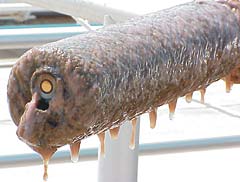Dissolved oxygen measurement is a crucial step in the activated sludge process in aeration basins. And this high-coating environment is among the most challenging applications for membrane sensors. To prevent coatings, which can put the sensor out of business,  manufacturers generally recommend cleaning the membranes weekly.
manufacturers generally recommend cleaning the membranes weekly.
Now, wastewater treatment plants are in step with most of industry these days, having to do more with fewer personnel while maintaining a good quality standard. The Rosemount Analytical division of Emerson Process Management came up with an answer: the Auto Air Blast System (AABS). What this system does is blow a jet of air for a period of one to three minutes over the sensor membrane at set intervals, such as every eight hours. A programmable timer in the analyzer controls the cleaning frequency, and a small, high-efficiency compressor near the sensor provides the air supply. A sensor that stays clean doesn?t need to be pulled for weekly maintenance.
In a five-month field test conducted at the Orange County, CA, sanitation municipal wastewater treatment facility, three sensors were placed near the outfall of the aeration basins. Only one survived into the second week, even though for ease of removal another had been mounted on a floating ball whose bouncing motion was expected to keep its passenger clean. The successful sensor, in the soup, was treated every 60 s for eight hours by the AABS.
Contact John Volbeda, Industry Manager for Water & Wastewater, Emerson Process Management, Rosemount Analytical, Liquid Division, Irvine, CA; 949-757-8357 direct, 800-854-8257, [email protected].